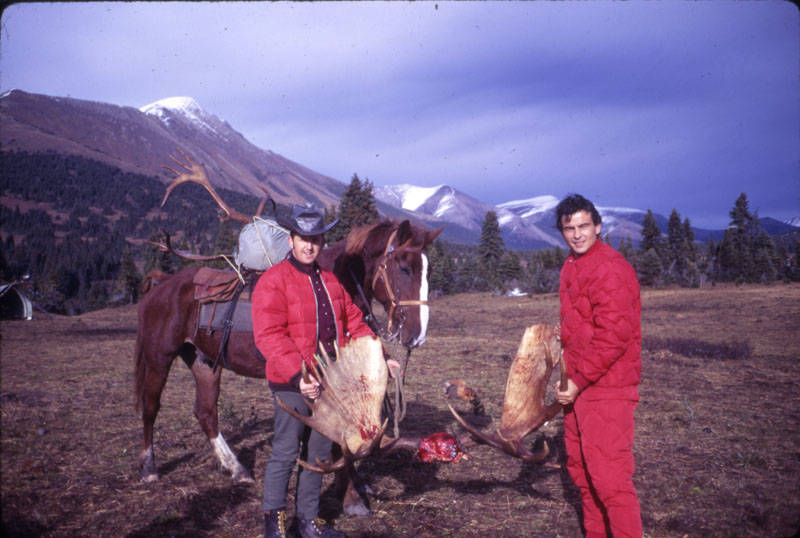Image: Reproduction from Jerry Stojan’s slide collection: Roddy Moberly (left) and Horst Buchholz (right) display the antlers from Buchlolz’s moose. (SPRA 2018.040.23)
Jerry Stojan emigrated from Czechoslovakia with his parents in 1926. Jerry married Irene Lenoir of Ontario, and they had two children, Charles and Linda. Though Jerry spent many years occupied as a farmer and horseman, he also enjoyed time as a hunter and avid outdoorsman. In his later years, Jerry pursued a career as a hunting guide and outfitter.
Jerry’s team packed horses into the mountains southwest of Grande Prairie and established base camps before hunting season. The Kakwa-area mountains where Jerry brought his clients were home to big game animals such as sheep, caribou, elk, moose, and bear. He often worked with local guides, including Roddy Moberly and Alex Moberly. Jerry’s clients harvested animals both for their meat and trophies.
In 1969, Jerry coordinated two hunts for the American Broadcasting Corporation to be featured in the television series The American Sportsman. In a letter to the show’s producers, Jerry committed “30 head of horse (10 saddle and 20 pack) tents, heaters, camp cook, spotter, packers, food bedrolls etc. as per [their] telephone conversation” for the hunt. The episodes would feature singer Vic Damone hunting bighorn sheep and actor Horst Bucholtz hunting moose.
On October 10th, the Daily Herald-Tribune reported “the stars are whizzing through [the] city airport” as these two celebrities crossed paths in Grande Prairie: Damone leaving after a successful hunt and Bucholtz arriving to begin his own. The article boasted that “every other hunter that has gone to the camp has got his animal, with the help of Indian callers; and under the watchful eye of the Stojans it is hard to imagine anyone not getting a moose.” Horst Bucholtz was indeed successful hunting a moose.
Airing throughout the United States, The American Sportsman episodes emphasized the beauty of the Albertan Rockies, the thrill of hunting big game animals, and the knowledge of the local hunting guides. Observing a herd of caribou with Vic Damone, Jerry explains “they’re starting to move down to the winter range. They normally range about ten, fifteen miles west of here and they migrate about sixty miles off to winter range down on the Kakwa River.” Later, approaching the bighorn sheep shot by Damone, Jerry demonstrates how to determine its age by counting the growth ridges on its horns: “every year they’ll grow during the good feeding season and in the winter, they create a ridge. That’s how you count them.”
When the episodes originally aired , Jerry travelled to the United States to watch them; later, he was provided with 16mm film copies of the episodes that he shared with friends on a projector. Jerry’s daughter, Linda, recently donated these films and contextual archival documents to the Archives, as well as a collection of slides that document Jerry’s many years of hunting and guiding in the South Peace. These records will be added to the Jerry Stojan family fonds (fonds 253) to provide a more thorough narrative of Jerry’s life and career. They will also demonstrate how a sheep and a moose brought Hollywood to the South Peace and back again.
This article was originally featured in the September 2018 issue of Telling Our Stories.
